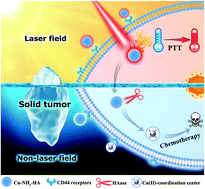The precise anti-tumor effect of a metallopolysaccharide-based nanotheranostic: turning phototherapy into programmed chemotherapy†
Abstract
Phototheranostic, a regional-focused treatment, can provide cancer theranostics with low damage due to their spatial precision. However, the precise elimination of residual cancer cells in laser-focused fields and in non-laser-focused fields is highly challenging. Herein, a novel metallopolysaccharide-based nanotheranostic (Cu–NH2–HA) is fabricated through a one-step coordination-driven nanoassembly, in which Cu2+ ions are coordinated with NH2-modified hyaluronic acid (NH2-HA). Based on the structural skeleton and dual-information-related functions of HA as well as the dual functions of Cu(II)-coordination centers, Cu–NH2–HA can selectively enter cancer cells to achieve photoacoustic imaging-guided photothermal therapy in a laser-focused field. More importantly, it can be transformed in situ by overexpressed endogenous hyaluronidase for programmed chemotherapy of residual cancer cells in a non-laser-focused field. This work demonstrates for the first time that metallopolysaccharide-based smart nanotheranostics can be used to achieve precise phototheranostic and enzyme-driven programmed chemotherapy for temporospatially controllable combination therapeutics in solid tumors, providing a promising in situ transformation strategy to overcome formidable challenges in anti-tumor applications.



 Please wait while we load your content...
Please wait while we load your content...